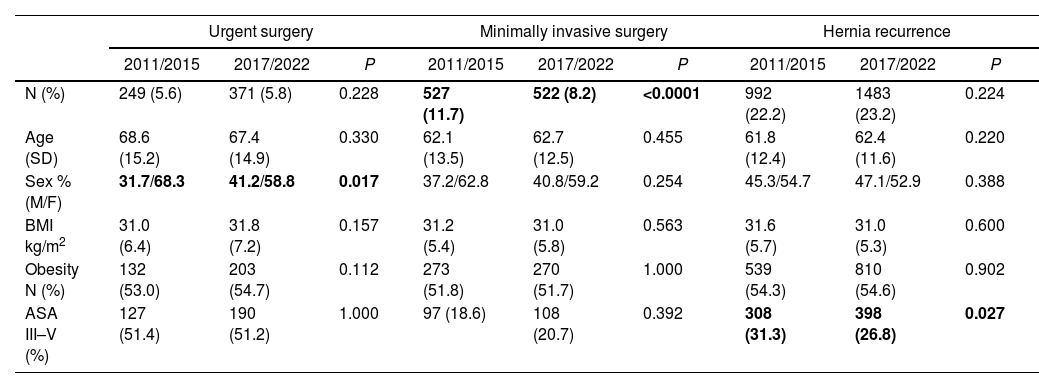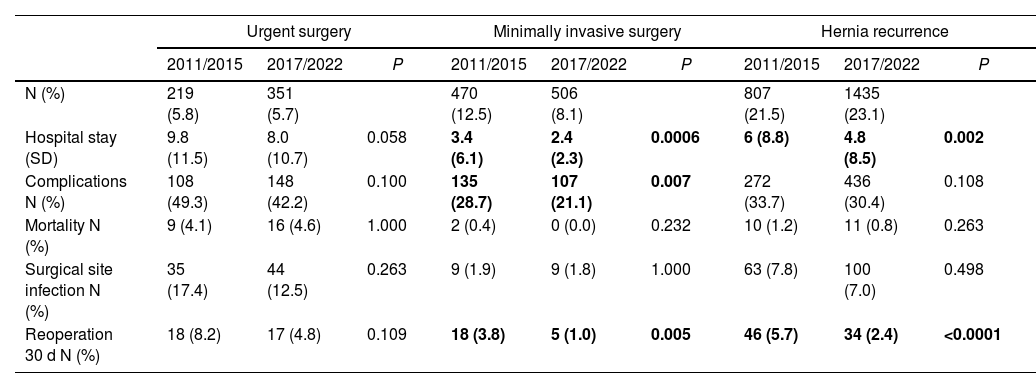The aim of this study was to assess the utility of the EVEREG registry in evaluating the evolution of surgical treatment for incisional hernia and its outcomes in Spain by comparing data from 2 study periods.
MethodsA retrospective comparative analysis of hernia surgeries performed between 2011 and 2015 (first period) and between 2017 and 2022 (second period) was conducted using data collected from the EVEREG registry.
ResultsStatistically significant differences were observed in the second cohort, including: a decrease in minimally invasive procedures (11.7% vs 8.2%; P < .001), an increase in emergency surgeries for males (31.7% vs 41.2%; P = .017), an increase in trocar hernia repairs (16% vs 26.2%; P < .0001), a reduction in suture repairs (2.8% vs 1.5%; P < .0001), and an increase in retromuscular techniques (36.4% vs 52.4%; P < .001) in open surgery with mesh.
In elective surgery, there was a decrease in the average length of stay (4.9 vs 3.8 days; P < .0001), the percentage of complications (27.9% vs 24.0%; P < .0001), reoperations (3.5% vs 1.4%; P < .0001), and mortality (0.6% vs 0.2%; P = .002).
Long-term outcomes included a decrease in recurrences after 12 months (20.7% vs 14.5%; P < .0001) and in chronic pain (13.7% vs 2.5%; P < .0001) and chronic infections (9.1% vs 14.5%; P < .0001) after 6 months.
ConclusionIn recent years, there has been a significant improvement in the outcomes of incisional hernia treatment. The registry serves as a fundamental tool for assessing the evolution of hernia treatment and enables the identification of key areas for improvement and the evaluation of treatment outcomes.
El objetivo del estudio fue comprobar la utilidad del registro EVEREG para evaluar la evolución del tratamiento quirúrgico de la hernia incisional y sus resultados en España, comparando los datos de dos períodos de estudio.
MétodosAnálisis retrospectivo comparativo de las hernias operadas entre 2011 y 2015 (primer período) y entre 2017 y 2022 (segundo período) usando los datos recopilados en el registro EVEREG.
ResultadosSe detectaron diferencias estadísticamente significativas en la cohorte más reciente en: disminución de abordaje mínimamente invasivo (11,7% vs. 8,2%; P < 0,001); incremento de varones intervenidos de urgencia (31,7% vs. 41,2%; P = 0,017); incremento de las reparaciones de hernias de trócar (16% vs. 26,2 %; P < 0,0001); reducción de reparaciones sin malla (2,8% vs. 1,5%; P < 0,0001); aumento de técnicas retromusculares (36,4% vs. 52,4%; P < 0,001) en la cirugía abierta con malla.
En la cirugía electiva disminuyó la estancia media (4,9 vs. 3,8 días; P < 0,0001), el porcentaje de complicaciones (27,9 % vs. 24,0%; P < 0,0001), reintervenciones (3,5% vs. 1,4%; P < 0,0001) y mortalidad (0,6% vs. 0,2%; P = 0,002).
A largo plazo se produjo una disminución de recurrencias a los 12 meses (20,7% vs. 14,5%; P < 0,0001) y del dolor (13,7% vs. 2,5%; P < 0,0001) e infección crónicos (9,1% vs. 14,5%; P < 0,0001) a los seis meses.
ConclusiónSe ha producido una importante mejora de los resultados en el tratamiento de la hernia incisional en los últimos años. El registro es una herramienta fundamental para comprobar la evolución del tratamiento de las hernias y permite discernir los principales puntos para implementar mejoras y evaluar los resultados de estas.













